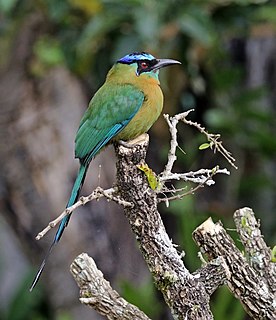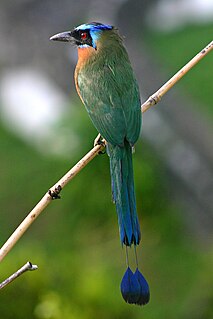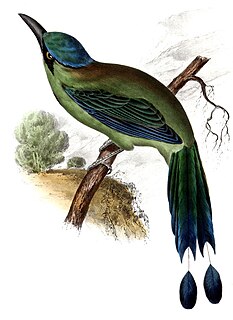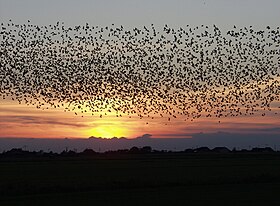
Hornbills (Bucerotidae) are a family of bird found in tropical and subtropical Africa, Asia and Melanesia. They are characterized by a long, down-curved bill which is frequently brightly colored and sometimes has a casque on the upper mandible. Both the common English and the scientific name of the family refer to the shape of the bill, "buceros" being "cow horn" in Greek. Hornbills have a two-lobed kidney. They are the only birds in which the first and second neck vertebrae are fused together; this probably provides a more stable platform for carrying the bill. The family is omnivorous, feeding on fruit and small animals. They are monogamous breeders nesting in natural cavities in trees and sometimes cliffs. A number of mainly insular species of hornbill with small ranges are threatened with extinction, namely in Southeast Asia.

The Amazonian motmot is a colorful near-passerine bird in the family Momotidae. It is found in the Amazon lowlands and low Andean foothills from eastern Venezuela to eastern Brazil and northeastern Argentina.

The green kingfisher is a resident breeding bird which occurs from southern Texas in the United States south through Central and South America to central Argentina.

The sacred kingfisher is a medium-sized woodland kingfisher that occurs in mangroves, woodlands, forests and river valleys in Australia, New Zealand and other parts of the western Pacific.

The Amazon kingfisher is a resident breeding kingfisher in the lowlands of the American tropics from southern Mexico south through Central America to northern Argentina.

Bucerotiformes is an order of birds that contains the hornbills, ground hornbills, hoopoes and wood hoopoes. These birds were previously classified as members of Coraciiformes. The clade is distributed in Africa, Asia, Europe and Melanesia.

The green-and-rufous kingfisher is a resident breeding bird in the lowlands of the American tropics from southeastern Nicaragua south to southern Brazil.

Hombron's kingfisher or the blue-capped kingfisher is a species of bird in the family Alcedinidae endemic to the Philippines and found only on Mindanao. It is one of the most colorful kingfishers in the country having a dark blue cap and wings with rufous spots, a striped rufous belly, white chin and red bill. Its natural habitats are on the upper ranges of tropical moist lowland forest and tropical moist montane forests. It is threatened by habitat loss.

Lesson's motmot or the blue-diademed motmot, is a colorful near-passerine bird found in forests and woodlands of southern Mexico to western Panama. This species and the blue-capped motmot, whooping motmot, Trinidad motmot, Amazonian motmot, and Andean motmot were all considered conspecific.

The tree kingfishers or wood kingfishers, subfamily Halcyoninae, are the most numerous of the three subfamilies of birds in the kingfisher family, with around 70 species divided into 12 genera, including several species of kookaburras. The subfamily appears to have arisen in Indochina and Maritime Southeast Asia and then spread to many areas around the world. Tree kingfishers are widespread through Asia and Australasia, but also appear in Africa and the islands of the Pacific and Indian Oceans, using a range of habitats from tropical rainforest to open woodlands.

The Trinidad motmot is a colorful near-passerine bird endemic to the forests and woodlands of Trinidad and Tobago. This species and the blue-capped motmot, Lesson's motmot, whooping motmot, Amazonian motmot, and Andean motmot were all considered conspecific. Though found on both islands, this bird is more abundant in Tobago than it is in Trinidad.

The Andean motmot or highland motmot is a colorful near-passerine bird found from northern Colombia to western Bolivia.

The blue-capped motmot or blue-crowned motmot is a colorful near-passerine bird found in forests and woodlands of eastern Mexico. This species and the Lesson's Motmot, Whooping Motmot, Trinidad Motmot, Amazonian Motmot, and Andean Motmot were all considered conspecific. The IUCN uses blue-crowned as their identifier for this species, however it was also the name used for the prior species complex.




































